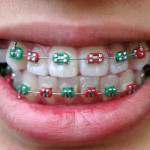
Fixed appliance orthodontic treatment is a routine part of contemporary orthodontics delivering good treatment outcomes. However, it is associated with a number of adverse effects including white spot lesions, root resorption, and loss of alveolar bone and periodontal attachment.
The aim of this review was to assess whether fixed appliance treatment resulted in clinical attachment loss.
Methods
Searches were conducted in the Medline, Embase, Cochrane Central Register of Controlled Trials, Cochrane Database of Systematic Reviews, Scopus, Web of Knowledge, Virtual Health Library, Google Scholar and ISRCTN registry databases. Randomised controlled trials (RCTs) and prospective or retrospective non-randomized clinical trials on periodontal healthy human patients receiving comprehensive fixed appliance treatment were considered.
Two reviewers independently selected studies, abstracted data and assessed risk of bias. The Cochrane tool was used for RCTs and the ROBINS-I (Risk Of Bias In Non-randomized Studies – of Interventions) tool for non-randomised studies. Paule-Mandel random-effects meta-analyses of the clinical attachment loss and its 95 per cent confidence intervals (CIs) were calculated.
Results
- 9 prospective non-randomised trials involving a total of 335 patients were included.
- Average age of the patients = 22.6 years (range 11.4–42.1 years).
- All 9 studies included periodontally healthy patients, while two studies also provided a group of patients with previous periodontitis that had been treated successfully and showed no signs of inflammation; these patient groups were extracted separately.
- 7 out of the 9 studies provided comprehensive orthodontic treatment
- 8 studies were considered to be at moderate risk of bias and 1 at high risk.
- Comprehensive orthodontic treatment was associated with a mean clinical attachment loss of 0.11 mm (95 per cent CI: 0.12 mm gain to 0.34 mm loss; P = 0.338, I2 = 99.6%), which was neither statistically nor clinically significant
- Meta-regression analysis showed a significant modifying effect of patient age on clinical attachment loss (P = 0.018), with older patients experiencing less attachment loss.
Conclusions
The authors concluded: –
According to existing evidence from prospective longitudinal studies comprehensive orthodontic treatment with fixed appliances might have little to no clinically relevant detrimental effect on the clinical attachment levels of patients with malocclusion.
Comments
The reviewers have undertaken an extensive literature search involving a wide range of databases and followed a sound methodological approach. None of the identified studies were randomised trials but all were prospective studies. However, as the authors note, the included studies were limited in number and small which could influence the findings. The overall GRADE assessment for the available evidence is low to very low.
Links
Primary Paper
Papageorgiou SN, Papadelli AA, Eliades T. Effect of orthodontic treatment on periodontal clinical attachment: a systematic review and meta-analysis. Eur J Orthod. 2017 Jul 4. doi: 10.1093/ejo/cjx052. [Epub ahead of print] PubMed PMID:29106513.
Original review protocol on PROSPERO
Other references
Dental Elf – 22nd Jul 2016
